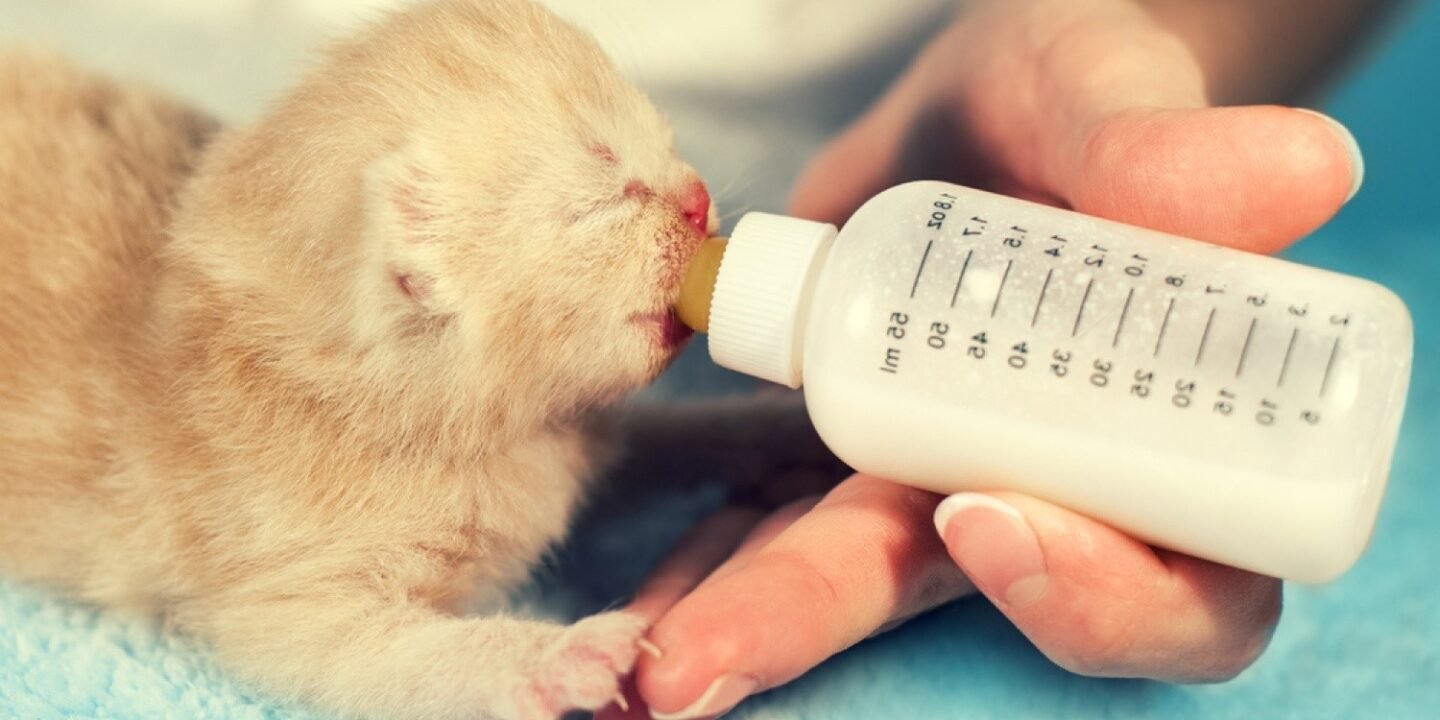If you’re caring for a newborn kitten, the first thing to know is this: they cannot drink cow’s milk or eat solid food. Newborns must be fed with a kitten milk replacer (KMR) using a bottle or syringe, and every feeding needs to be done correctly to keep them safe.
This guide shows you exactly how to feed a newborn kitten step by step—from preparing formula and the right feeding position, to how much and how often to feed based on weight. You’ll also learn what to do if the kitten won’t latch, how to burp and stimulate them after feeding, and the red flags that mean you need a vet right away.
Key Takeaways: How to Feed a Newborn Kitten
- Warm first: Never feed a cold kitten. Warm them gently before offering milk.
- Use kitten milk replacer (KMR): Do not give cow’s or goat’s milk.
- Correct position: Place the kitten belly-down; never on their back.
- Feed by weight and age: Small, frequent meals every 2–3 hours in the first week.
- Burp and stimulate: Help the kitten urinate/defecate after each feeding.
- Track growth: Weigh daily—healthy kittens should gain steadily.
- Call a vet: If the kitten won’t eat, loses weight, or shows signs of aspiration (milk from the nose, coughing).
Newborn Kitten Feeding Chart (Age, Frequency & Amount)
| Kitten Age |
Feeding Frequency |
Amount per Feeding* |
Notes |
| 0–1 week |
Every 2–3 hours (8–12x/day) |
2–6 ml |
Always keep the kitten warm before feeding. |
| 1–2 weeks |
Every 3 hours (8x/day) |
6–10 ml |
Burp gently after each meal. |
| 2–3 weeks |
Every 4 hours (6x/day) |
10–14 ml |
Begin seeing stronger suckling. |
| 3–4 weeks |
Every 5 hours (4–5x/day) |
14–18 ml |
Start introducing a shallow dish of KMR. |
| 4–5 weeks |
4x/day |
18–22 ml |
Transition to gruel (KMR mixed with wet kitten food). |
| 5–6 weeks |
3–4x/day |
22+ ml |
Gradually switch to wet kitten food. |
*Note: Amounts are approximate and should be adjusted to the kitten’s weight (average daily intake = 8–12 ml per ounce of body weight, divided into feedings).
The Right Way to Feed (Technique That Prevents Aspiration)
Position: Always place the kitten on their belly, with their head in a natural, level position. This mimics how they would nurse from their mother and keeps the airway protected. Never feed a kitten on their back or in a vertical “baby” hold like a human infant—this greatly increases the risk of formula entering the lungs and causing aspiration pneumonia.
Latch: Hold the bottle so the nipple is filled with formula, but not dripping rapidly. Gently introduce the nipple into the kitten’s mouth and allow them to begin suckling on their own. The key is to let the kitten control the pace of feeding—do not squeeze the bottle forcefully, as this can overwhelm them and push liquid into the airway.
Pace: Kittens need time to suck, swallow, and breathe. Watch closely for steady suckling and take short breaks if the kitten seems to gulp or pause. After each feeding, burp the kitten gently by holding them upright against your chest or over your hand and softly patting their back. This helps release swallowed air and prevents bloating.
Syringe feeding: If a kitten is too weak to latch or refuses the bottle, syringe feeding can be used as a backup. Place the tip of the syringe into the side of the kitten’s mouth and release only a drop or two of formula at a time into the cheek pouch. Allow the kitten to swallow before giving more. Never squirt a large amount at once, as this can cause choking or aspiration.
After Every Feed—Burping, Toileting, and Logging
Burping: Just like human babies, kittens can swallow air while feeding. After every meal, hold the kitten upright against your chest or support them over your hand with their belly resting down. Gently pat or rub their back until you hear or feel a small burp. This step prevents gas buildup, discomfort, and bloating.
Toileting (urination and defecation): Newborn kittens cannot eliminate waste on their own until around 3–4 weeks of age. After each feeding, use a warm, damp cotton ball, soft tissue, or cloth to gently rub the kitten’s genital and anal area in small circular motions. This stimulates urination and bowel movements, mimicking what their mother would do. Always clean and dry the area afterward to avoid irritation.
Logging progress: Keeping detailed records is one of the most important parts of newborn kitten care. After each feeding, write down the time, how many milliliters of formula the kitten drank, and whether they urinated or defecated. Weigh the kitten once daily in grams on a digital kitchen scale and record the number. Healthy kittens should gain weight steadily each day. If a kitten fails to gain weight for more than 24 hours or loses weight, it’s a red flag that requires prompt veterinary attention.
Related: How to Litter Train a Kitten
Weaning Timeline (Weeks 3–5)
By the time kittens reach 3 to 4 weeks of age, their suckling reflex begins to weaken, and they start showing curiosity about food sources beyond the bottle. This is the natural signal to begin weaning. At this stage, you can place a shallow dish of warmed kitten milk replacer (KMR) in front of them and gently guide their noses toward it. Some kittens may step into the dish or lick from their paws at first—this is normal learning behavior.
As interest builds, transition to a soft “gruel” mixture made by blending kitten milk replacer with a high-quality, pate-style wet kitten food. The consistency should be creamy enough for easy lapping. Feed this in small amounts several times a day while continuing bottle feeding until the kitten consistently eats from the dish.
By 4 to 5 weeks, most kittens will eat gruel readily and can gradually move to primarily wet kitten food, with less reliance on formula. At this stage, provide a shallow dish of clean, fresh water at all times. Remember, cow’s milk is not a safe substitute—it can cause diarrhea and does not meet a kitten’s nutritional needs [ASPCA].
Proper weaning is gradual: never stop bottle feeding abruptly. Each kitten progresses at a slightly different pace, but by the end of week 5, most are ready to fully transition to wet food, with water as their main source of hydration.
Troubleshooting & Red Flags
Won’t latch: If a kitten refuses the bottle, the first step is to check body temperature—a cold kitten cannot be fed safely. Warm them gently until they are alert. If still not latching, try a different nipple type, adjust the hole size for a slower flow, or use a syringe to give tiny drops of formula into the side of the mouth. Never force-feed, as this increases aspiration risk.
Gulping, coughing, or milk from the nose: Stop feeding immediately if you see these signs. Keep the kitten’s head slightly angled down to clear the airway. These are signs of formula entering the lungs (aspiration), which can quickly lead to pneumonia. Watch for labored breathing or nasal discharge, and seek veterinary care right away.
Diarrhea, constipation, or bloating: These problems often occur when the formula is mixed too concentrated, the kitten is fed too quickly, or overfed. Double-check your mixing ratio and feeding technique. If diarrhea, constipation, or bloating persists despite adjustments, contact a veterinarian promptly—dehydration can develop quickly in newborns.
Not meeting volumes or losing weight: Healthy kittens should gain weight daily. If your kitten is consistently refusing the recommended amounts of formula or is losing weight, this is an urgent red flag that requires a same-day veterinary visit.
Emergency formula (last resort): If you cannot access commercial kitten milk replacer right away, some rescues suggest temporary homemade substitutes. However, these are only for emergencies and should be replaced with KMR as soon as possible, since they don’t provide complete nutrition.
First 24 Hours Plan (Hour-by-Hour)
The first day with a newborn kitten is the most delicate. A structured plan helps prevent hypothermia, dehydration, and stress. Here’s how to navigate the first 24 hours after rescuing or receiving an orphaned kitten:
Hour 0–1: Warmth and Initial Setup
Immediately provide gentle warmth—using a heating pad on low or a towel-wrapped hot water bottle—since neonatal kittens cannot regulate their own body temperature until at least three weeks of age, making external heat essential to prevent hypothermia [Kitten Lady][HumanePro].
Next, perform a basic health check: assess breathing, movement, hydration (gums’ moisture and color), and rectal temperature to detect hypothermia [Maddie’s Fund].
Weigh the kitten using a gram-scale and start a care log, as guidelines recommend daily weighing in kittens under two weeks to monitor growth accurately [PMC].
Hour 1–2: Formula Prep and First Feeding
Prepare a small batch of kitten milk replacer (KMR), ensuring it’s warmed to about body temperature (98–100°F). Test nipple flow: drops should fall slowly, not stream. Gently offer the first feed with the kitten on its stomach, never on its back, to reduce aspiration risk. Feeding should be slow and controlled.
Every 2–3 Hours: Core Cycle
Maintain a strict cycle:
- Feeding with the right volume per weight
- Burping over your shoulder or hand
- Toileting stimulation with a warm, damp cloth until the kitten is around 3–4 weeks old
- Logging exact time, amount fed, urine/stool, and behavior
- Sanitizing bottles and nipples after every session
According to Cornell Feline Health Center, missing even one feeding in the first week can be life-threatening
Bedtime Setup: Safety & Preparation
Before sleeping, secure the kitten in a warm, draft-free nest with a steady heat source that cannot cause burns. Set alarms for every 2–3 hours overnight. Pre-measure sterile formula bottles in the fridge to save time during night feeds. This preparation ensures you can respond quickly without mistakes when you’re tired.
Key Tip: The first 24 hours are about stabilization—warmth, safe feeding, and close monitoring. Many neonatal losses occur from chilling or aspiration, so vigilance here can make the difference between life and death.
📖 Sources: Cornell Feline Health Center, ASPCA Kitten Care Guidelines.
FAQ’s
Can I give cow’s milk?
No. Kittens cannot properly digest cow’s milk, and it often causes diarrhea and dehydration. Always use a commercial kitten milk replacer (KMR).
How warm should the formula be?
Feed lukewarm, close to body temperature (around 100°F / 37–38°C). Warm the bottle in a water bath, never in a microwave (which creates dangerous hot spots).
How long between feeds at night?
In the first week, kittens must be fed every 2–3 hours—even overnight. As they grow and gain weight steadily, you can gradually stretch intervals.
When can kittens start drinking water?
Not before weaning. Introduce a shallow dish of clean water when you begin offering gruel around 3–4 weeks.
What if the kitten feels cold?
Never feed a chilled kitten. Feeding while hypothermic can cause aspiration and gut stasis. Warm gently with a heating pad or your body heat before offering formula.
When to Call the Vet
Even with the best care at home, newborn kittens can decline quickly, so knowing when to seek veterinary help is essential. Contact a veterinarian right away if you notice any of the following warning signs:
- Poor feeding: The kitten is not eating the expected volume or refuses to eat.
- Respiratory distress: Milk comes from the nose during feeding, or you notice coughing, gagging, wheezing, or labored breathing.
- Digestive issues: Severe or persistent diarrhea, or complete absence of urine or stool after multiple feed–stimulate cycles.
- Growth problems: No weight gain—or worse, weight loss—over 24 to 48 hours despite proper feeding.
- Lethargy: Weakness, low responsiveness, or sudden collapse.
Because neonatal kittens have almost no reserves, even small problems can become emergencies. The American Veterinary Medical Association (AVMA) stresses that prompt veterinary intervention is critical to survival in fragile kittens.
👉 Pro tip for U.S. owners: Establish care with a local, cat-savvy emergency clinic in advance so you know where to go if urgent issues arise. It’s also wise to keep the ASPCA Animal Poison Control Center (888-426-4435) number handy in case of accidental exposure to toxins.
Bottom line: If you are unsure whether something is normal, it’s always safer to call your veterinarian. Quick action can make the difference between life and death for an orphaned kitten.





